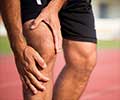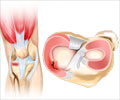Arthroscopy for Knee Ligament Injury
The strength and stability of the knee joint depends on the strength and integrity of the ligaments that support the joint. When the ligaments are torn or damaged, most often due to excessive force during sports activity, the movement at the knee joint becomes restricted and painful limiting one’s activities.
When other measures such as rest, using protective knee braces or pain killers prove ineffective, surgery for repair of the torn or damaged ligaments becomes necessary. Usually surgery becomes necessary because of a complete tear in the ligament which makes the joint unstable and frequently buckle or give away.
The surgery is performed generally using an endoscope called arthroscope.
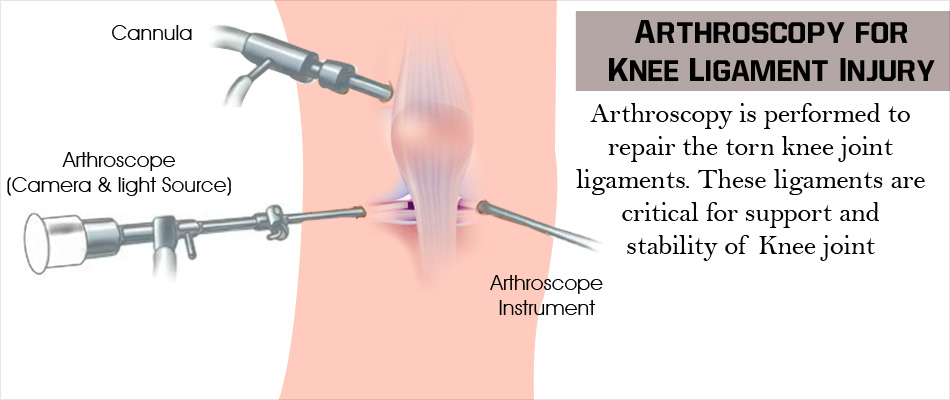
Knee Joint - In brief
Knee joint is a joint that occurs where two long bones of the lower limbs meet. Consequently, the knee joint occurs where the lower ends (condyles) of the thigh bone or femur meet the upper ends (condyles) of the shin bone or tibia. It is the largest joint in the body.
In addition, it also consists of the articulation (communication) between the knee cap or patella and the thigh bone.
The movements possible at the knee joint include flexion (bringing the lower part of the leg towards the thigh) and extension (moving the lower part of the leg away from the thigh) and some degree of rotation.
The strength and stability of the knee joint depends to a great extent on the strength and integrity of the ligaments, which are tough, elastic bands of connective tissue that connect the thigh and shin bones namely the femur and tibia respectively.
The 4 ligaments of the knee that are commonly injured include the –
- Medial collateral ligament – situated on the inner aspect of the knee joint providing stability to that part
- Lateral collateral ligament – situated on the outer aspect of the knee joint providing stability to that part
- Anterior cruciate ligament – situated in the front of the knee joint; controls the forward movement of the shin bone
- Posterior cruciate ligament – situated in the back of the knee joint; controls the backward movement of the shin bone
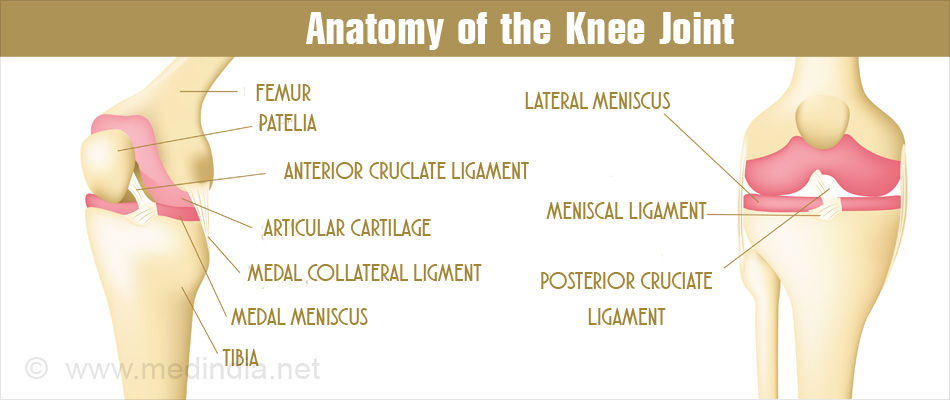
Depending on the force and stress subjected to, either a sprain or tear may occur.
Preparation for Surgery in Out-patients
Once surgery is decided the doctors will generally take you through the following –
- The procedure is explained, in order to voice any concerns or doubts you may have.
- A thorough and detailed history of prior and current illnesses and list of medications, history of drug allergies, and previous surgeries is obtained.
- Thorough physical examination to rule out any incidental abnormalities
- Laboratory tests such as blood and urine tests, chest X-ray and ECG to rule out any concomitant disease
- Tests to find out bleeding or clotting abnormalities that might cause excessive bleeding during the surgery
- Aspirin and pain relief medications should be discontinued for 7-10 days before surgery as they interfere with clotting.
- You are advised to stop smoking for a week prior to surgery
- The doctor has to be informed if there is a likelihood of being pregnant.
- It may be necessary to consult a physical therapist before the surgery and discuss post-operative rehabilitation options.

- Depending on your health condition, certain specific measures or preparations may be requested by the doctor before surgery
What is the Preparation for Arthroscopy for Knee Ligament Injury?
The Night before the surgery
- If you are admitted the previous day, a good night’s rest is important before the surgery.
- It maybe advisable to take a sleeping tablet if you have problems with sleep. Some units may administer this as a routine and others may only prescribe it if a request is made.
- Excess hair present on the surgical area may be shaved off.
- A light meal is advised.
- The nurses may do blood tests or other investigations if they have not been done previously.
- If you think you may have difficulty in passing your bowels in the morning ask for a laxative tablet.
- Test doses of antibiotics may be done as instructed by the surgeon.
- Normally if surgery is planned at 8 am, you will not be allowed to drink or eat anything after midnight. However, if it is planned later in the afternoon, an early morning (5 or 6 am) light snack and a drink will be allowed.
The Morning of the Surgery
- Do your usual normal chores such as brushing and going to the toilet as you would normally do at home.
- Take a shower and scrub yourself well with soap to disinfect the area of surgery.
- The nurse may do blood tests in the morning especially if you are a diabetic.
- If you have blood pressure you maybe advised to take your morning tablet, however these instructions are best left with the anesthetist.
What is the Procedure of Arthroscopy for Knee Ligament Injury?
The surgery is undertaken in the hospital by a qualified and skilled orthopedic surgeon. The procedure may be performed under general anesthesia when you are asleep or under spinal anesthesia, when the body below the waist is rendered insensitive while you are awake, but sedated.
The specific options and preferences will be discussed before the surgery however if you wish to voice a preference you should not hesitate in discussing it with the anesthetist.
- You will be provided a sterile gown to wear and after being positioned on the operating table, an intravenous line is started.
- Following administration of the anesthetic agent, your vital parameters such as heart rate, blood pressure and respiration are continuously checked by the anesthetist
- The skin over the area to be operated is cleaned with sterile antiseptic solution and draped with sterile surgical cloth.
- Several small incisions are made on the skin over the knee joint and a small tube with one end illuminated (arthroscope) is introduced into the joint cavity to visualize the interior.
- During the procedure, the surgeon may simply reattach the torn edges of the damaged tendon if the injury is simple. If the tear is more extensive, he may use grafts (piece of tissue) from the tendon of the kneecap, the hamstring tendon or other autografts (tissue from the same individual) to reconstruct the torn ligament. In certain cases, the graft may also be obtained from a donor (allograft).
- The surgeon drills holes in the thigh bone and shin bone where the damaged ligament was attached to the bone. The graft tissue is threaded through the holes into the joint and anchored in place with the help of surgical staples or screws. Eventually bone grows around the graft.
- The incisions are closed with stitches or staples and the skin wound is covered with dressing
What Happens After the Procedure?
After the procedure, you will be shifted to a recovery room where the vital parameters will be monitored for some time. Once they stabilize you, the nurses will shift you to the room or the ward.
You maybe discharged on the same day or the following day.
Before discharge, exercises may be prescribed to follow at home and crutches or knee immobilizer may be advised.
Aftercare at Home
- Adequate rest and sleep

- Proper diet and nutrition
- Remaining ambulant without overstraining
- It may be necessary to have someone at home to assist with daily activities for a few days till you are able to resume normal activities by himself or herself.
- Keeping the wound area clean and dry and following specific bathing instructions
- Taking the prescribed medications and pain medications recommended regularly
- Continuing the prescribed exercises with the physical therapist
- Keeping the leg elevated and applying an ice bag to the knee several times a day for the first few days to reduce swelling.
- The doctor must be immediately consulted in the event of fever, increasing pain, and bleeding or discharge from the surgical wound.
- A follow-up visit with the surgeon to review the progress will be necessary usually about a week after the surgery during which the stitches or surgical staples will be removed.
What are the Risks and Complications of the Procedure?
Knee ligament repair surgery is a safe procedure with minimal risks or complications. However, any procedure is fraught with certain risks that include
- Bleeding – The cause of bleeding whether a clotting abnormality or a torn vessel within the wound has to be identified and the bleeding stopped as soon as possible.
- Infection – Post-operative infection is usually controlled with intravenous antibiotics during the hospital stay followed by a course of oral antibiotics at home.
- Blood clot in the legs or lungs (venous thromboembolism) – Due to prolonged immobility following surgery, some persons may develop clots in the legs or lungs and have to be anticoagulated.
Most patients recover well after surgery and regain mobility of the joint and freedom from pain. Certain activities have to be restricted. Complete recovery and resumption of intense exercise and activities may take a few months.
What are the Exercises Prescribed After Knee Ligament Repair?
Following surgery, exercises are prescribed under the rehabilitation program to strengthen the joint and regain full mobility. The exercises are grouped into phases depending on the nature of the injury, the type of surgery undertaken and the surgeon’s advice.
Phase I
Phase I exercises typically begin within a week after the surgery under the supervision of a physical therapist. The range of motion exercises taught helps to increase knee joint mobility.
By four weeks, one should be able to bend the knee by 90o. The focus will be on strengthening the muscles on the front of the thigh (quadriceps), which are key to walking and weight bearing. These exercises are performed lying down to avoid strain to the knee.
Phase II
This phase begins within 4-6 weeks and involves exercises that can be done in a standing position. Range of motion exercises are continued from Phase I. Other additional exercises include stationary biking to improve motion at the knee joint. Balance exercises, such as standing on one leg may also be added during this phase.
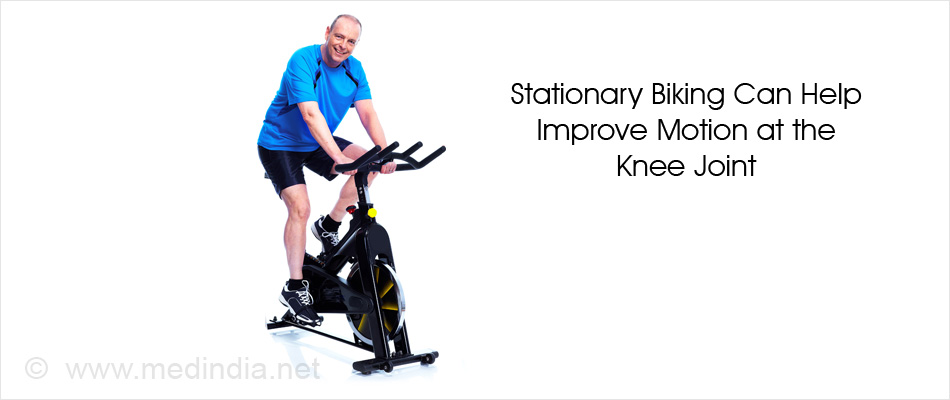
Phase III
This begins about 8 weeks after surgery. Resistance to movement is added during the exercises to aid strengthening of the joint. Exercise machines such as the elliptical machine or stair stepper may be added during this phase. Knee exercises such as leg press, squats, and step-ups are included gradually increasing the difficulty quotient. Swimming and pool
running can also be added at this stage.
Phase IV
This phase begins around 6 months following surgery. Exercises include sprinting, jumping and other sport-specific, high-intensity movements. It may be essential to wear a knee brace during the exercises to prevent reinjury or tear of the ligaments.


